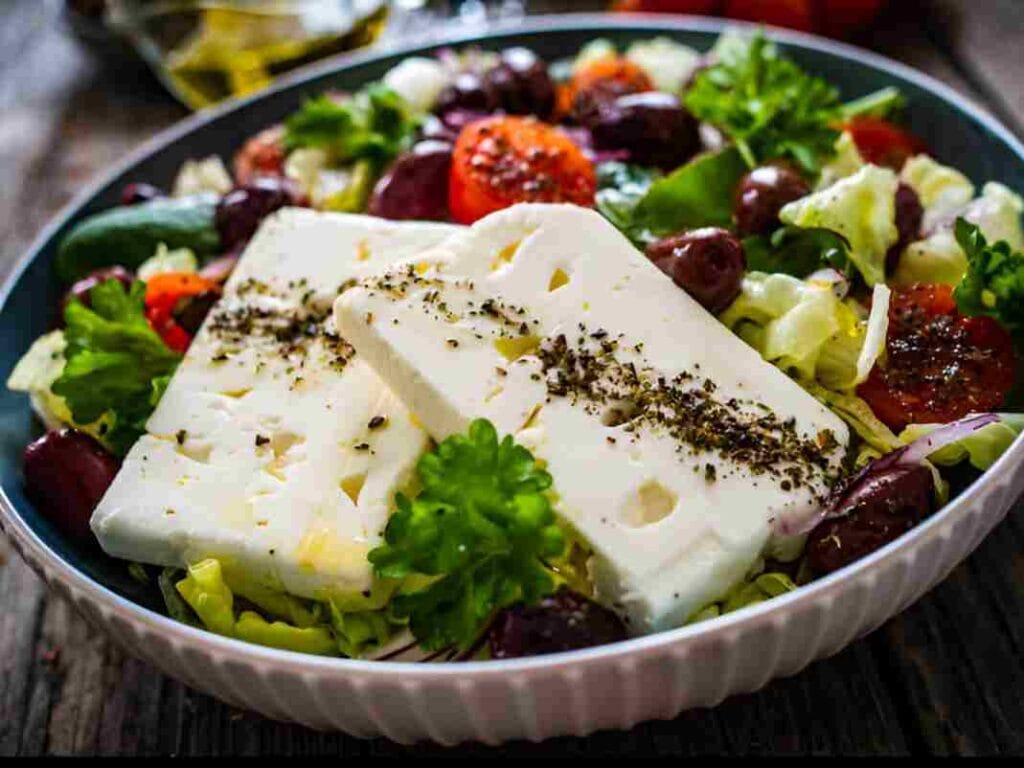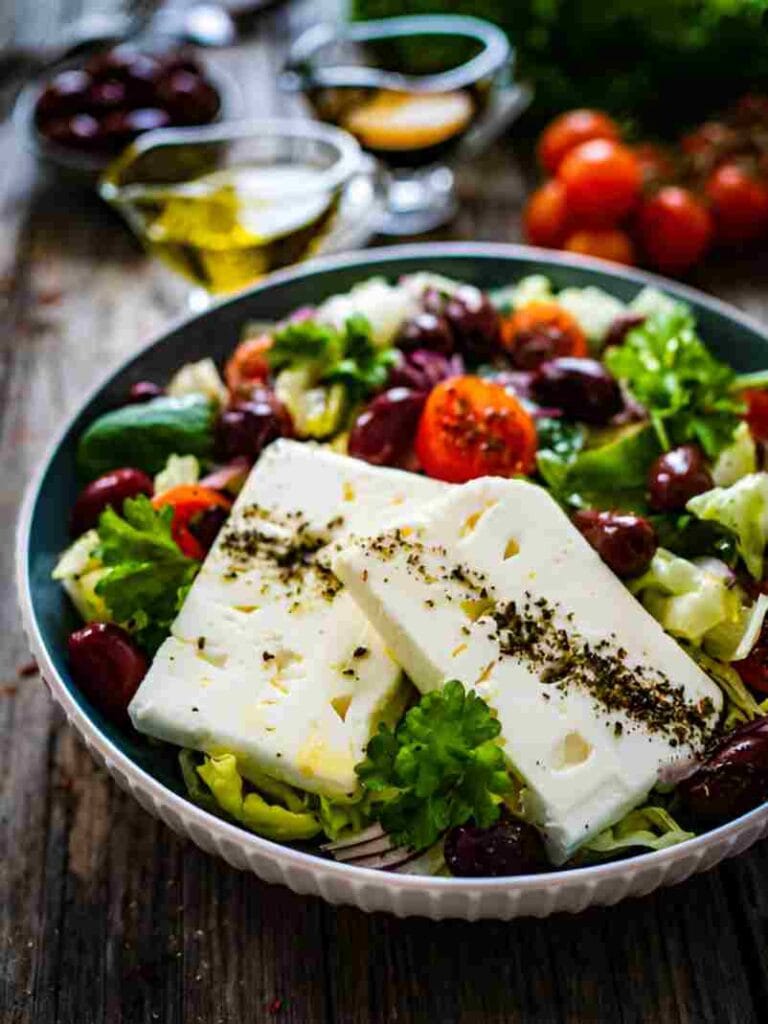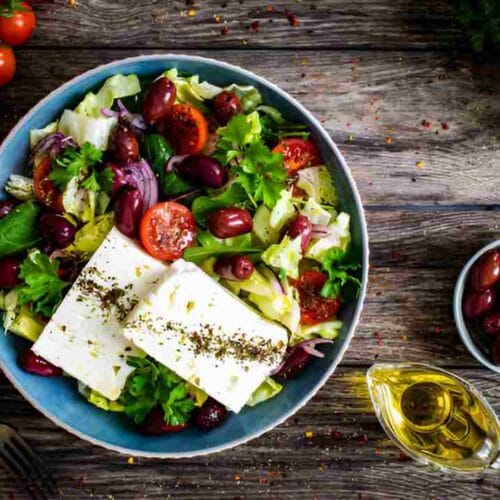Greek Salad has become a staple dish for many families, offering a vibrant mix of fresh ingredients that create a flavorful and nutritious meal. With its colorful presentation and refreshing taste, it’s no wonder this dish is a hit at family gatherings, picnics, and even weeknight dinners.

Table of Contents
Why You’ll Love Greek Salad
Perfect for Families
One of the biggest draws of Greek Salad is its ability to please everyone at the table. It’s quick to prepare, which makes it ideal for busy families. No cooking is required—chop, mix, and enjoy! With its diverse range of flavors, each bite is a delightful taste adventure that everyone will appreciate.
Nutritional Benefits
Greek Salad is not only delicious but also incredibly nutritious. Packed with vitamins from fresh vegetables, healthy fats from olives and feta cheese, and protein, it’s a balanced option that supports a healthy lifestyle. Plus, it allows you to consume a variety of food groups in just one dish!
Flexibility
The adaptability of Greek Salad is another reason to love it. You can customize it based on what’s in your fridge or your family’s preferences. Budgets are also considered, as seasonal vegetables are often less expensive and can enhance your meal without breaking the bank.
Essential Ingredients for the Recipe
To whip up a delightful Greek Salad, gather the following ingredients:
- Ingredients
- 4 large ripe tomatoes, cut into wedges
- 1 cucumber, thickly sliced
- 1 red onion, thinly sliced
- 1 green bell pepper, julienned
- 200g (7oz) block feta cheese
- ½ cup Kalamata olives
- 2 tbsp capers (optional)
- 1 tsp dried oregano
- Dressing:
- ¼ cup extra virgin olive oil
- 2 tbsp red wine vinegar
- ½ tsp sea salt
- ¼ tsp black pepper
Cucumber
Cucumber is the backbone of this refreshing Salad, providing a crunchy texture that balances the juiciness of the tomatoes. If you’re out of cucumbers, consider using zucchini as a substitute for a slightly different flavor.
Feta Cheese
Feta cheese adds a tangy creaminess to Greek Salad. If you prefer a non-dairy option, try using tofu feta or avocado blended with nutritional yeast for a creamy texture without dairy!
Olives
Kalamata olives bring a briny richness to the dish. If you’re not a fan, feel free to swap them out for green olives or even capers for a punch of flavor. Ensure that you choose quality olives for the best taste.
Ingredient Preparation
Step 1 – Wash and Chop Your Vegetables
Begin by washing all your vegetables thoroughly. Cucumbers should be halved and sliced into half-moons, while bell peppers should be chopped into thin, bite-sized strips. Halve or quarter your tomatoes, depending on size, and slice the red onion into thin half-rings.
Step 2 – Prepare the Feta
While the veggies are being chopped, take the feta cheese and marinate it with olive oil and oregano in a separate bowl. This step enhances the flavor of the cheese and ensures it will complement the vegetables perfectly.
Step 3 – Mix the Ingredients
Gather all your chopped ingredients in a large mixing bowl. Gently add the marinated feta and olives, being careful to keep the feta pieces intact. This step ensures every bite is full of flavor, and the visual appeal makes serving easy!
Step-by-Step Cooking Instructions
Step 1 – Initial Preparation
While there’s no cooking involved, having all your ingredients prepped and ready is essential. Ensure you have a large bowl to accommodate all ingredients and a whisk prepared for the dressing.
Step 2 – Ingredient Assembly
Start by combining the chopped cucumber, bell peppers, red onion, and tomatoes in a large bowl. Add in the Kalamata olives and ensure everything is evenly distributed. Be gentle to maintain the integrity of the vegetables.
Step 3 – Dressing and Finishing Touches
In a separate bowl, whisk together the olive oil, freshly squeezed lemon juice, and seasoning (salt and pepper). Pour this dressing over the Salad and toss gently to coat all ingredients. Garnish with oregano for that final touch of flavor and aroma.
Tips for an Even Tastier Version
Adding Extra Ingredients
Want to take your Greek Salad to the next level? Consider adding in some chopped avocado for creaminess, or throw in some freshly chopped herbs like parsley or mint for a burst of freshness.
Techniques to Enhance Flavor
Try marinating the Salad for about 30 minutes before serving. This allows the flavors to meld together beautifully, making each bite even more enjoyable. You can also drizzle some balsamic glaze over the top before serving for an unexpected twist!
Adjustments for Preferences
If you’re accommodating specific diets, such as vegan or gluten-free, there are plenty of substitutions available. Olive oil is gluten-free, so focus on those dressings that align with your dietary needs.
Recipe Variations and Adaptations
Vegetarian Option
For those who prefer a heartier salad, consider adding chickpeas or quinoa to the mix. They provide protein and make the Salad even more filling without compromising on flavor.
Gluten-Free or Low-Carb Option
If you need a low-carb alternative, skip out on carb-laden sides and serve the Greek Salad on a bed of greens like spinach or arugula. They act as a delightful base without the heaviness of bread.
Other Adaptations
Seasons may dictate what vegetables are best—try adding in fresh basil in the summer or roasted vegetables in the colder months for a different flavor profile.
Serving Suggestions
Salad or Soup Ideas
Greek Salad makes for a light and refreshing starter. Pair it with a side of miso soup or a simple vegetable broth to balance the meal.
Hearty Sides
Add some homemade tzatziki with pita bread or roasted vegetables to complete your meal. They serve as great accompaniments and enhance the Greek theme perfectly!
Drink Recommendations
For a delightful pairing, serve it chilled with a nice glass of white wine or a refreshing mint lemonade for an adventurous spin.

Storage and Reheating Tips
How to Store Leftovers
If you have any leftovers, store them in an airtight container in the refrigerator. Greek Salad is best eaten fresh, but it can last up to 2 days!
Reheating Techniques
Since Greek Salad is served cold, reheating isn’t necessary. Just give it a mix before serving to redistribute the dressing.
Portioning Tips
Consider preparing individual portions for meal prep. This way, you can enjoy Greek Salad throughout the week with minimal effort.
Nutritional Information and Benefits
Nutritional Values per Serving
Generally, one serving of Greek Salad contains about 320 calories, depending on the amount of dressing and added ingredients, making it a guilt-free dish packed with flavor.
- Serving Size: 1/4 of salad
- Calories: 320
- Sugar: 8g
- Sodium: 850mg
- Fat: 25g
- Saturated Fat: 8g
- Unsaturated Fat: 15g
- Trans Fat: 0g
- Carbohydrates: 15g
- Fiber: 4g
- Protein: 9g
- Cholesterol: 35mg
Ingredient Benefits
Tomatoes are rich in vitamin C and antioxidants, while cucumbers offer hydration. The healthy fats from olives promote heart health, and feta cheese contributes calcium and protein.
Recommended Portions
Aim for about 1 to 2 cups per serving, which gives a balanced intake of vegetables and flavor while fitting effortlessly into different dietary plans.
Common Mistakes to Avoid
Issue 1 – Overdressing
More isn’t always better when it comes to Salad. Start with a small amount of dressing and add more as necessary to avoid sogginess.
Issue 2 – Not Using Quality Ingredients
Always opt for fresh, quality ingredients. A dull salad can often result from low-quality produce. Speak to local farmers, visit farmer’s markets, or use organic options whenever possible.
Issue 3 – Chopping Sizes
Uniformity in chopping will make the Salad more enjoyable. If pieces are uneven, some bites can be overpowering or lack flavor. Aim for consistent sizes when chopping your veggies.
Inspiring Conclusion
Greek Salad is more than just a dish; it’s a celebration of fresh ingredients and bold flavors. This recipe is a fantastic way to bring family and friends together while enjoying the joys of cooking. Don’t hesitate to mix and match ingredients, create your own variations, and share your unique take on this classic dish. Happy cooking!
FAQ (Frequently Asked Questions)
- 1. Can I prepare this recipe in advance? Absolutely! You can chop the vegetables a few hours beforehand. Just wait to add the dressing until you’re ready to serve to keep it fresh.
- 2. What are the best substitutes for feta cheese? If you’re looking for a non-dairy option, try using tofu feta or blanched almonds blended with lemon juice for creaminess.
- 3. How long does this Salad last in the fridge? Greek Salad is best enjoyed fresh, but it can last up to 2 days in the refrigerator when stored in an airtight container.
- 4. Can I add meat to Greek Salad? Yes! Grilled chicken or shrimp are excellent options to make it heartier.
- 5. What’s the best way to chop an onion without crying? Chill your onion in the freezer for 10-15 minutes before chopping. This can help reduce the release of irritating compounds!
- 6. Is Greek Salad healthy for weight loss? Yes! With fresh vegetables and healthy fats from olives and olive oil, it can be part of a balanced diet for weight management.
- 7. Can I add fruits to this Salad? Definitely! Adding fresh fruits like watermelon or strawberries can give a delightful twist and sweetness to the flavor profile.
- 8. What type of olive oil should I use for the dressing? Extra virgin olive oil is recommended for its rich flavor and health benefits.
- 9. How can I make the Greek Salad vegan? Omit the feta cheese or replace it with a plant-based alternative like avocado or tofu.
- 10. Can I serve Greek Salad as a main dish? Absolutely! Add some protein like chickpeas or quinoa to transform it into a filling main dish.
Embrace the wonderful flavors and colorful presentation of Greek Salad. It’s not just a recipe; it’s an experience waiting to be enjoyed!
Quick Chicken Caesar Pasta Salad Delight

Greek Salad
Ingredients
- 4 large ripe tomatoes, cut into wedges
- 1 cucumber, thickly sliced
- 1 red onion, thinly sliced
- 1 green bell pepper, julienned
- 200g (7oz) block feta cheese
- ½ cup Kalamata olives
- 2 tbsp capers (optional)
- 1 tsp dried oregano
Dressing:
- ¼ cup extra virgin olive oil
- 2 tbsp red wine vinegar
- ½ tsp sea salt
- ¼ tsp black pepper
Instructions
- Prepare Vegetables: Combine tomatoes, cucumber, onion, and bell pepper in large bowl.Add Toppings: Place whole feta block on top (don't crumble). Scatter olives and capers around.Make Dressing: Whisk together olive oil, vinegar, salt, and pepper.Assemble: Drizzle dressing over salad. Sprinkle oregano on feta.Serve: Toss gently at the table, breaking feta into chunks as you mix.
Notes
- Authentic version uses whole feta block (not pre-crumbled)
- Best served immediately (gets watery if left too long)
- Add 1 tsp honey to dressing for balance (optional)

